| Glossary | ||
| The Vertebrates | Pa-Pl |
| Vertebrates Home | Vertebrate | Vertebrate | Bones | Time |
For most phrases beginning with directional words, e.g. "posterior," "dorsal," "external," etc., or some generic anatomical terms, e.g., "vena," look under the next word in the phrase. However, note that this convention is not used with complete consistency in this Glossary.
P Permian. q.v.
P/p in mammaliform dentition, an upper (P) or lower (p) premolar.
Pace in locomotion, "The pace resembles the trot, in which pairs of fore and hind legs are moved together, with a period of suspension between the movement of each fore-/hindlimb pair during which all four feet are off the ground. However, in the trot, contralateral pairs of fore and hind legs are moved simultaneously (e.g., left fore with right hind), whereas the pace involves ipsilateral pairs of legs (e.g., left fore with left hind). The pace prevents the fore and hind leg on the same side from interfering with each other during fast locomotion, allowing a longer stride length, and hence a faster and more efficient mode of locomotion than the trot. Three distinct types of pace gait can be distinguished in extant Camelus: a slow pace, where the animal may be supported for four legs during some part of the locomotory cycle; a medium pace, where the animal is only ever supported by two legs; and a fast pace, where there are times during the cycle when no legs are on the ground. The fast pace is the one that would be termed a 'running pace' by Hildebrand (1976)." Janis et al. (2002).
Pachyosteosclerosis pachyostosis (bone thickening), combined with replacement of trabecular bone with compact bone. Madar 1998).
Pachyostosis increase in thickness of bone. Sometimes used as a synonym of pachyosteosclerosis. "Pachyostosis functions to increase an aquatic animal's density so that it approaches that of water, and the degree of pachyostosis usually increases with size and age [citations omitted]. It appears that lung volume (and thus buoyancy) increases allometrically with weight, such that older, larger animals have proportionately more positive buoyancy [citations omitted]. The corresponding increase in the degree of pachyostosis with age appears to compensate for this [citations omitted]." Lee et al. (1999: 516).
Pacinian corpuscle a weird neurosensory structure which looks like an onion on a string. This is a characteristic pressure receptor of therian mammals.
Paedomorphosis the retention of juvenile characters into adult life. Opposite of peramorphosis.
Palatal Arch palatines + pterygoids. Lee et al. (1999a).
Palate the bones of the roof of the mouth, esp.: vomer, palatine, pterygoid, ectopterygoid, parasphenoid. Depending on context and author, may include maxilla and premaxilla, as well as any braincase elements which are exposed on the roof of the mouth.
Palatine (transverse) torus the torus palatinus, palatine torus: a bony protuberance sometimes found on the hard palate at the junction of the intermaxillary suture and the transverse palatine suture.
Palatobasal articulation of the palatoquadrate. Same as basipterygoid articulation (?). A ventral articulation of the palatoquadrate in which the palatoquadrate articulates with a process on the basisphenoid. See image at paratemporal articulation.
Palatobasal ridge in sharks, a ridge formed by the ventral part of the ethmoid articulation of the palatoquadrate. In essence, this is a lateral ridge anteroventral to the orbit. See Synechodus for an example.
Palatoquadrate The primitive upper jaw formed from the hypothetical mandibular arch. See Gill Arches, Gnathostomata, Synechodus,and (especially) the glossary entry at pterygoid.
Paleocene Epoch The first epoch of the Cenozoic (65.0-54.8 Mya). The Early Paleocene is the Danian Age (65.0-61.0 Mya). The Middle Paleocene is not formally recognized. In these Notes, it refers to the Selandian Age (61-57.9 Mya). The Late Paleocene includes both the Selandian and Thanetian and thus the entire period from 61-54.8 Mya. However, in these Notes, and where there is enough information to make a distinction, it refers only to the Thanetian (57.9-54.8 Mya).
Paleognathous palate see Paleognathae
Paleomagnetism When igneous rock is first extruded from the mantle, it usually cools slowly enough that small crystals of magnetic iron in the rock orient toward the magnetic poles as they exist at the time. When the rock cools, the positions of the crystals are frozen -- barring remelting, folding, secondary magnetization, etc. By making a great many, very finicky, measurements it is sometimes possible to reconstruct the original orientation and the original dip (variation from the horizontal). The direction can often be used to determine whether the Earth's magnetic poles were normal or reversed. Since the sequence of these magnetic reversals is well known for some periods of Earth's history, a series of reversals over an exposure can sometimes date its levels quite precisely. When information on dip is available, it may be possible to reconstruct the approximate latitude of the landmass where the rock was found. The Earth's magnetic field is horizontal at the (magnetic) equator and vertical at the (magnetic) poles. The relationship between dip and latitude is straightforward and allows a reasonable approximation of magnetic latitude. With a large number of measurements, and with sample ages spread over about 100,000 years, the effect of random magnetic pole "wander" can be averaged out, so that true geographic latitude can be computed as well. Surprisingly, this type of calculation has been corroborated often enough that high quality paleomagnetic data, when and if available, has now become the gold standard for reconstructing the latitude of the continents during the Paleozoic and Proterozoic. Paleomagnetic studies do not yield direct information about longitude. However, samples of the same age, taken from different locations on the same continent, can be used to establish rotation of the continent.
Paleostylic jaw suspension in which the jaw and braincase are not connected. Apparently, a common condition in children and politicians.
Paleozoic Era Traditionally, the first era associated with the presence of abundant multicellular life, 543-248 Mya. The Paleozoic Era includes the Cambrian (543-490), Ordovician (490-443), Silurian 443-417), Devonian 417-354), Carboniferous (354-290) and Permian (290-248 Mya) Eras. The Era began with recovery from a period of intense glaciation, and ended with the Permo-Triassic mass extinction.
Palmar see plantar for confusing "explanation."
Palpebral odd bones of uncertain function that often originate on the anterior margin of the orbit and arch over the orbit -- seemingly blocking vision in part. Palpebrals are common in, for example, the ornithischian dinosaurs. However, in Stegosaurians, the palpebrals are modified to form an extra series of supraorbitals. One might speculate that the eyes of most other ornithischians (and other dinosaurs) were frontated and that vision was commonly directed over the bridge of the nose, rather than down the snout. This would have a number of advantages.
Pamprodactyl of bird feet, having all four toes in front, as in swifts.
Panniculus L. diminutive of pannus = cloth or covering. Hence a little covering.
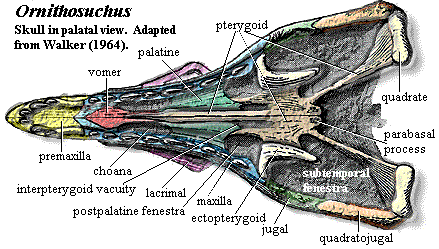
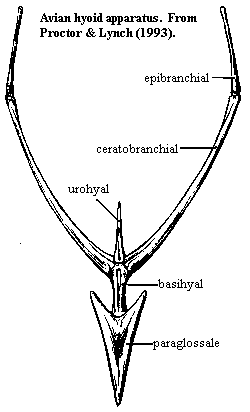
Panniculus carnosus, m. fine, flat muscles within the hypodermis. Their origin is in the deep fascia of bone and they insert into superficial skin. They act to raise hair, quills, feathers, etc. It is also used in "twitch" reflexes to shake off insects, etc. See Untitled lecture notes).
Papilla amphibiorum in Lissamphibia, at least, a sensory area in the wall of the sacculus of the inner ear, sensitive to sound frequencies below 1000 Hz (the papilla basilaris is sensitive to frequencies above 1000 Hz).
Parabasal process (of the pterygoid) a posteriorly directed process of the pterygoid near the midline for articulation with the basipterygoid processes of the basisphenoid. Walker 1964).
Parabasisphenoid a term for the conjoined basisphenoid and parasphenoid, used mainly by Gower and Clack.
Parachordal In early development, two pairs of cartilaginous rods form parallel to the notochord in the cranium: the anterior trabeculae and the posterior parachordals. These form the foundation for the development of the braincase.
Parachucla Formation Late Oligocene of Florida. Nearshore environment with sirenians and occasional land mammals. MacFadden & Morgan (2003).
Paraconeone of the major cusps of a tribosphenic upper molar, typically in the antero-buccal corner, q.v. and Molars.
Paradiapophyseal lamina reinforcing ridge bone ridge in the vertebrae (normally, of sauropods) connecting the parapophysis with the diapophysis on the same side. See image at centrodiapophyseal lamina.
Parafibula an unusual third bone of the lower leg, normally restricted to the area of the knee, in multuberculates, monotremes and some therians.
Paraglossale in the avian hyoid apparatus, the arrowhead-shaped bone which forms the base of the tongue.
Paralectotype Each specimen of a former syntype series remaining after the designation of a lectotype.
Paramedian on each side of a line down the middle. Used mostly by archosaur folk to describe the placement of osteoderm (armor) plates with respect to the vertebral column. Thus imbricating pairs of paramedial osteoderms (Sues, 1992: 143) means "with pairs of overlapping armor plates flanking the backbone."
Parampular process in Actinistia, a posterior process from region of semicircular canals which bridges to occipital region. See image at Actinistia.
Paraphyletic (of a group) a group which does not contain all of the descendants of its last common ancestor.
Parapophysis (pl. parapophyses) the articulating surface for the lower, capitular branch of the rib. See diagrams at diapophysis and zygapophyses. For a much better diagram, see Untitled Document. In those vertebrae which bear well-developed ribs, a tubercle near the end of the rib articulates at a tubercular facet on the transverse process diapophysis), while the end, or head, of the rib articulates at a more ventral capitular facet which is sometimes developed into a second, or ventral, transverse process, the parapophysis. The parapophysis is often spoken of as if it were always a process of the neural arch. However, it may extend from the centrum as well. In some papers, the diapophysis and parapophysis are referred to as the upper and lower parapophyses, respectively. See, e.g. Sander (1989).
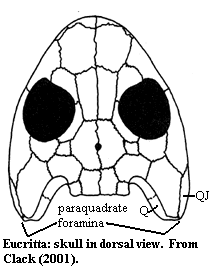
Paraquadratic foramen
a foramen in the quadratojugal or, more likely, a foramen for the quadratojugal located on the quadrate.
This feature -- whatever it is -- appears to be of considerable importance in the systematics of ornithischians.(Dinosaurian ungulates (Ornithopods) (November 12)).
paraquadrate foramen a small, round hole located along the suture between quadratojugal and quadrate in basal tetrapods, e.g. Eucritta. Clack (2001).
We have no information on the relationship, if any, between 1 and 2.
Parasagital parallel to the long axis (but not on the midline); parallel to the midline. A parasagittal section is a vertical slice made other than on the midline.
Parasagittal gaitstyle of locomotion in which the limb moves more or less parallel to the midline of the body.
Parasphenoid a dermal bone of the palate. Despite the name, it is not part of the braincase. One might speculate that the name is derived from the fact that the parasphenoid runs along the midline of the posterior palate, parallel to (and often functionally replacing) the usual path of the basisphenoid. Then again, one might -- very easily -- have better things to do.
Parasternal process in basal tetrapods, the posterior "stem" of the interclavicle. This may be a developmental artifact. See Note under Eucritta.
Parasymphysial on either side of the a symphysis, normally referring to the point at which the two halves of the lower jaw are joined.
Parasymphysial plate a plate of dermal bone, normally denticulated or bearing a fang pair, which lies across, or just behind, the point where the two halves of the lower jaw meet, i.e. the dentary (or mandibular) symphysis.
Parasymphysial tooth whorl or spiral. A possible gnathostome synapomorphy. This structure is more easily illustrated than explained:
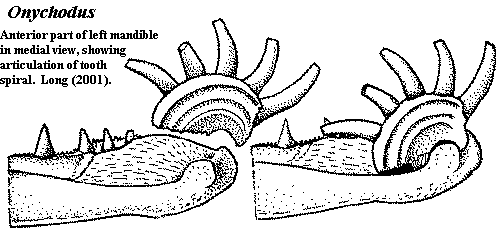
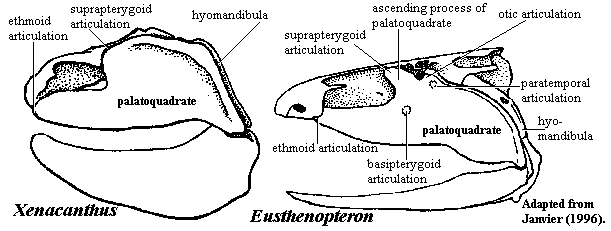
Paratemporal articulation of the palatoquadrate. One of the possible dorsal articulations of the palatoquadrate in which the palatoquadrate articulates with a process on the epihyal.
Paratype Each specimen of a type series other than the holotype.
Paravertebrae bony projections lying along side neural spines -- probably same as ossified tendons common in ornithopod dinosaurs. See Dann's Dinosaur Info: MINMI.
Paraxial locomotionlocomotion in which the propulsive force is applied by limbs, flippers or otherwise away from the axis of motion.
Paraxial mesoderm see Early Development Terms.
Parhypural in fish tail anatomy, the last hemal spine that forms part of the hypural plate. It is considered a typical hemal spine or a hypural by some authors, but is recognized as distinct because it bears a hypurapophysis (i.e., a process for the origin of the anterolateral portion of the hypochordal longitudinal muscle which inserts on the upper principal caudal fin rays) and is notched to allow the caudal artery to exit the hemal canal. It also supports the lowermost principal caudal fin ray, e.g. in Siluriformes. See image at urodermal.
Paroccipital process A usually long cross-bar across the back of the skull formed by the exoccipitals and/or opisthotic. See The Prootic. The paroccipital process apparently (a word which signals my gross ignorance) may have contributions from the exoccipitals, opisthotic, and even the crista prootica of the prootic.
Parsimony In phylogenetic systematics, "parsimony" is the principle that the phylogeny which requires the least number of character changes is the most likely to be correct. In this form, parsimony is neither a logical assumption nor a necessary condition for cladistics. It is simply the working or null hypothesis. That is, parsimony is assumed only when there is no reason to believe that another path was followed. In this form, parsimony is not really different from the classical understanding that a phylogeny which requires convergences and/or reversals is less likely than one which does not. A stronger version of the parsimony principle is less often expressly stated, but is often applied. The strong version states that the use of numerous character traits increases the strength of the parsimony assumption. The argument is that, because reversals and convergences are statistically rare events, it is only necessary to use a large enough number of characters to swamp any such aberrations. With enough data, so the thought goes, parsimony graduates from being a null hypothesis to being an independent argument for phylogeny, the strength of which is limited only by the statistics of large numbers. This strong form of parsimony is valid statistical reasoning. However, if parsimony is used as more than a null hypothesis, it becomes sensitive to the truth of various assumptions. The most significant of these is the statistical independence of the measured character traits. We are just beginning to understand how groups of characters are governed genetically. We know very little about how selective pressures affect groups of characters; and, much of the time, we have no idea what the functional significance of a character is (i.e., what does it do for/to the organism), much less how it relates to the functional units of selection or genetic regulation (whatever they may be). Thus, the strong form of parsimony is attractive as an idea, but it is generally untestable at present because its assumptions cannot be verified.
Parastylar lobe in symmetrodont dentition, the mesiobuccal) lobe of the upper molar containing the parastyle and B/stylocone. The image at stylocone shows several upper molars with relatively large parastylar lobes.
Parastyle in mammalian cheek teeth, a (usually small) cusp on the anterior stylar shelf near the paracone.
Paroccipital process may be considered a process of the opisthotic, but the process may be formed by bones in addition to, or even instead of, the opisthotic. The paroccipital process runs horizontally and sometimes dorsally) across the back of the skull. It joins the occiput and braincase to the quadrate, squamosal and the other dermal bones of the "cheek." See Braincase or Opisthotic.
Parotic plate oblong, denticulated palatal bones which covered the anterior end of the notochord in some sarcopterygian groups. Also referred to as arcual plates. See image at arcual plate.
Parietal foramen unpaired midline foramen located on the parietals for the tetrapod median "eye." See, e.g. image of Eucritta above under paraquadratic foramen. This term is used as a neutral alternative to "pineal foramen" since the light sensitive organ within the foramen may not be the pineal in all cases -- it may be the epiphysis.
Patagium a flight membrane as in bats, pterosaurs, and gliding animals.
Patuxent Formation Early Cretaceous to middle Cretaceous of Maryland, USA. White or light gray to orange-brown, moderately sorted, cross-bedded, argillaceous, angular sands and subrounded quartz gravels; silts and clays subordinate, predominately pale gray.See Geologic Maps of Maryland: Coastal Plain Rocks and Sediments. Arundel Clay facies believed to be Middle Aptian.
Pavement dentition teeth formed as a broad, crushing surface.
Paw Paw Formation Early Cretaceous II (Albian) of Texas.
Pectinate L. pecten = a comb. Adjective form of pecten, applied to anatomical structures with projections like the teeth of a comb.
Pectiniform same as pectinate.
Pectoral relating to the forelimb, esp. the attachment of the forelimb to the trunk.
Pectoral girdle the bones or cartilaginous structures in the trunk which articulate with the forelimb, including any parts which articulate with the spinal column or skull. These may include the scapula, coracoid(s) (if separate), cleithrum and associated elements, clavicle, interclavicle and sternum. The exact composition will depend on the type of organism.
PectoralisThe muscle which is largely responsible for the flight stroke in birds, or the digging stroke in moles. The pectoralis originates on the sternum and on the furcula (if present) and attaches on the anteroventral face of the humerus. In fishes, it originates on the medial face of the cleithrum.
Pedicel same as pedicle. Probably an incorrect spelling
Pedicle L. pes (pedis) = foot, and the diminutive suffix -culus. Hence a little foot; but the word also meant a stalk of fruit. From this latter comes the anatomical use, for the pedicle of an organ suggests the stalk of an apple or other fruit. The most common use of this word is in connection with the two ventral "stalks" of the ilium which contact the pubis and ischium and forms the posterior and anterior sides of the acetabulum. These are the pubic pedicle and ischial (or ischiac) pedicle, respectively.
Pedomorphosis the retention of juvenile characters into adult life. Opposite of peramorphosis.
Peduncle a pedunculate process. The most common use of this word is in connection with the two ventral "stalks" of the ilium which contact the pubis and ischium and forms the posterior and anterior sides of the acetabulum. These are the pubic pedicel or peduncle and the ischial (or ischiac) pedicel or peduncle, respectively.
Pedunculate hanging from or supported by a stalk.
Peel Sound Formation Late Silurian (Pridoli) to Early Devonian Pragian) of the Canadian Arctic. This unit is a red bed located on Prince of Wales and Somerset Islands and the Boothis Peninsula, surrounded (both geographically and temporally) by carbonates. CHAPTER 5 -CANADIAN ARCTIC ISLANDS BANKS BASIN. Marginal marine and estuarine environment of very low energy. Dineley (1976).
Pelage hair, fur, spines, or other keratinous dermal projections (not skin, scales, hooves, etc.). The term is usually only applied to mammals.
Pelite any lithified mudstone or other very fine-grained (i.e. clay) material.
Pelte- Gr. root = shield
Pelvic relating to the hind limb, esp. the attachment of the hind limb to the trunk.
Pelvic girdle the bones or cartilaginous structures in the trunk which articulate with the hind limb, including any parts which articulate with the spinal column. These may include the ilium, ischium and pubis.
Pelycosaur a paraphyletic group comprising all Synapsida except therapsids. The archetypal pelycosaur is Dimetrodon.
Pennaceous flat, sheet-like feathers or regions of feathers with ordered barbs. Not plumaceous.
Penultimate next to last.
Peramorphosis "a process by which the juvenile condition is modified from the ancestral, juvenile condition, and juvenile traits are completely or substantially modified." Jaime Headden.
Pericardial cavity one of the two primitive partitions of the coelom. The pericardial cavity contains the heart, and the pleuroperitoneal cavity contains the other internal organs. They are separated by the transverse septum.
Perichondral a type of bone which grows as a layer over the surface of a bone or cartilaginous structure from the fibrous perichondral (or periosteal) covering. Perichondral bone is formed directly, not preformed in cartilage.
Perilymphatic duct the duct in the inner ear that directs the perilymph (and the compression waves caused by sound) along the lagena (= cochlea) and into the metotic cavity.See figure at The Ear.
Periosteal around the outside of the bone. Typically applied to lamellar, acellular bone which coats the surface of endochondral bones. The shiny, white surface layer of many bones. Same as perichondral (q.v.) except that it surrounds other bone, rather than cartilage.
Periotic same as the petrosal, q.v.
Perisso- Gr. = "odd" in both senses of the English word, i.e. (a) strange and (b) integers not evenly divisible by 2.
Peritoneum see pleuroperitoneal cavity.
Permian The last period of the Paleozoic Era, between the Carboniferous and Triassic, approximately 290 to 248 Mya. As used here, the Lower Permian ("lwP") refers to the Asselian, Sakmarian, Artinskian and Kungurian Ages (290 - 256Mya), Middle Permian "mP" -- rarely used, as this is not a recognized epoch) refers to the Artinskian and Kungurian Ages (269 - 256Mya), and the Upper Permian "upP") refers to the Urmian-Kazanian and Tatarian Ages (256 - 248Mya).
Peroneal relating to the fibula.
Perpendicular plate the ventral continuation of crista galli of the ethmoid. It descends from the ethmoid through the nasal cavity, forming part of the nasal septum and articulating with the ascending processes of the vomers and palatines in the palate. See large figure at figure3.
Peskapoo Formation Paleocene Tiffanian) of Alberta. Freshwater lacustrine deposits. Wilson 1980).
Petrosal the fused otic capsule of mammals. It is homologous to at least the prootic and opisthotic, and may contain elements of the amniote supraoccipital as well. Sometimes referred to as the "periotic." The petrosal of mammaliforms and early mammals is described in considerable detail at Morganucodontidae and Triconodontidae.
Petrotympanic fissure the space between the ?medial rim of the bulla and the basicranium. Luo 1998).
Phalacanthous having dorsal fin spines, as in ctenacanthiforms. Opposite of anacanthous.
Phalanges Gr. phalanx = a packed triangular formation of infantry. Finger (or toe) bones.
Pharyngo- prefix referring to (a) the pharynx or nasal passage, or (b) the most ventral element of a gill arch. See Gill Arches.
Pharyngobranchial the most ventral element of a branchial arch.
Pharynx anterior portion of gut from which internal gills develop as a series of paired pouches.
Phylogenetic bracket A technique for inferring the unknown characters of an organism from the known characters of related organisms. Given the phylogeny:
If B and D are known to have a character, then, absent evidence to the contrary, we may infer that this character is common to all members of taxon A. Thus our working assumption should be that the extinct organism C also possessed that character. Crocodiles (B) and birds (D) generally demonstrate some level of parental care of hatchlings. Our default assumption is that this is common to all archosaurs (A), and was thus present in ornithischian dinosaurs, such as Stegosaurus C). Note that parental care is not a synapomorphy of archosaurs. The bracket is a method for making educated guesses. It is not a matter of strict logic, and applies only in the absence of evidence to the contrary. It could well be that stegosaurs hung around in bars all night and never paid their child support.
Phylospace a portmanteau word used to describe the placement of organisms in space, time and phylogeny. It is an evolving concept, so to speak.
Physostomous of swim bladders, having a connection (pneumatic duct) between the gas bladder and the esophagus, e.g. many freshwater fishes; fishes in which the air bladder is connected at some point to the digestive tract by an open duct. Some physostomous fishes use the gas bladder as temporary or supplementary organ of respiration (e.g. arapaima, gars, bowfin). FISHBASE
PIFE the m. pubo-ischio-femoralis externus an important leg adductor which runs from the ventral or lateral face of the pelvic girdle (the puboischiadic plate) to the femur. Its attachment on the femur is associated with the intertrochanteric fossa on the medial face of the femur, below the femoral head.

Pila antotica The sphenethmoid does not simply disappear over the course of tetrapod evolution. Rather, like a decrepit dwelling, it gradually sheds superstructure until only a few main beams remain. In development, the embryo still dutifully constructs these beams as a latticework of cartilage, although the frame will never be built out or ossified. One of these beams is the pila antotica. These pilae (since there are actually a pair) arise from either side of the dorsum sellae, the sturdy process which guards the pituitary fossa just in front of the hind-brain. The pilae rise anteriorly and medially from the dorsum sellae until the two processes meet in the middle. It then rises to the taenia marginalis which runs sagittal along the midline of the skull table, just under the dermal bones. In therapsids (at least), the pila forms the internal wall of the cavum epiptericum, and is lost in therian mammals.
Pilaster in architecture, a false or half-column built into a wall, usually as a decorative element. Hence, in anatomy, a long bone which overlies another so that it appears to be a cylinder partially enveloped by the bone it overlies. Common examples include the ascending ramus of the quadrate, as it merges with the quadrate ramus of the pterygoid, or the fibula, when reduced to a splint, as it appears to merge into the column of the tibia.
Pineal L. pinea = a pine cone. Presumably so named from the shape of this body. A light-sensitive body associated with the brain.
Pinna L. pinna = a wing. Applied to the external ear.
Pisiform L. pisum = a pea, and forma = form. one of the proximal carpal bones of the wrist. See figure at carpus.
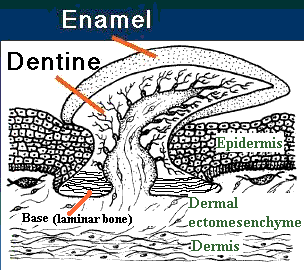
Placoid form of scale frequently found as microsquamation in chondrichthyans. With reference to the lepidomorial unit (if it has any continuing meaning), the crown grows at right angles to the base and the pulp cavity is filled with dentine or bone, leaving only narrow circulatory canals. It consists of one basic odontode unit. That is, it includes a pulp cavity covered with dentine. This is usually covered with a layer of enamel or enameloid, and is attached to the integument by a bony base.
Plagio-Gr. for slanted, inclined, or "to the side"
Plagiopatagium a flight membrane running between the body and the limb or digits.
Plantar This is a peculiar term which has become ambiguous because of the bizarre structure of bipedal primates. In human medical terminology, it generally means of, relating to, or occurring on the sole of the foot -- i.e., same as palmar or ventral and opposite of dorsal. See PALMAR, PLANTAR and DORSAL. This is fine for plantigrade organisms. However, in veterinary and more general use, plantar is used to describe the caudal facing aspect of the hind limb from the tarsus distally because this is the primitive ventral surface in embryonic development. In this sense it is still somehow) regarded as being the opposite of dorsal. However, for digitigrade (or unguiligrade) organisms, it is actually a posterior, caudal, or posterodorsal surface. We may summarize as follows for a generalized quadruped:
The problem is when the proximal tarsals themselves are illustrated. In this case, dorsal could mean proximal (i.e. the surface in contact with the epipodials - tibia, ulna, fibula, radius, or whatever) or the opposite of plantar (i.e. the front of the ankle). See Protocetidae for more information, illustrations, and perhaps a better rule of thumb (or toe as the case may be).
Plantigrade Feet in which parts enclosing the phalanges and metatarsals all touch the ground and bear significant weight in ambulatory (walking) locomotion.
Plate, perpendicular See Perpendicular plate.
Platycoelous of vertebral centra, flat ends -- neither procoelous anteriorly concave & posteriorly convex) or opisthocoelous vice-versa). Same as acoelous.
Pleromic used to describe a material that fills in interstices, spaces or gaps. Pleromic dentine is a relatively amorphous form of dentine, having fewer and less branched tubules, which fills in spaces in bone or in tubulate dentine.
Plesiomorphy (retention of a) primitive character. One of the important contributions of cladistics is its insistence that plesiomorphies carry no phylogenetic signal, i.e., they cannot be used to classify organisms.
Plesion in taxonomy, a word used and misused in various senses. Here it is used to mean a group consisting of a series of successive branches from a stem lineage which are united by plesiomorphic characters or homoplasies. This is not a clade. It is a paraphyletic grouping equivalent to a grade. Perhaps the best example of taxa arranged in a plesion are the early tetrapods between Acanthostegaand the temnospondyls. These forms seem to have stubbornly resisted all temptations to diversify, with each genus remaining as a separate, short-lived branch from the tetrapod stem lineage.
Plesodic of a fin, the condition in which the basals and radials reach to the distal margin of the fin. Opposite of aplesodic.
Pleural cavity In many amniotes, the lungs are separately partitioned off from the rest of the coelom, and particularly the pleuroperitoneal cavity, by a pulmonary fold (of the transverse septum?). The mechanism in mammals is somewhat different. See diaphragm.
Pleural ribs see ribs
Pleuroacrodont See Tooth Implantation.
Pleurocentrum the vertebral centrum associated with the neural arches. The pleurocentrum is formed between adjacent myomeres and is thus formed by two myomeres, as opposed to the intercentrum, which is formed in the center of a single myomere.
Pleurocoel an internal cavity in bone, usually presumed to be an air-filled space, presumably a weight-saving adaptation.
Pleurodont See Tooth Implantation.
Pleuroperitoneal cavity one of the two primitive partitions of the coelom. The pericardial cavity contains the heart, and the pleuroperitoneal cavity contains the other internal organs. They are separated by the transverse septum.
Pleurosphenoid See The Pleurosphenoid.
Pleurothecodont See Tooth Implantation.
Plicidentine "infoldings of dentine at the base of teeth, forming striations" Lee 1997a). "Infolding of the dentine into the pulp cavity (plicidentine) that results in faint grooves on the enamel surface close to the base of the tooth crown." [former site]
Plumaceous "fluffy" feathers or regions of feathers in which the barbs are not ordered. Not pennaceous.
checked ATW060208